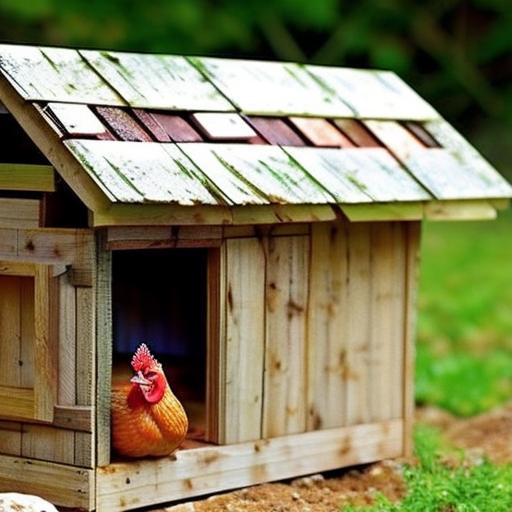When it comes to building a chicken coop, one of the most important considerations is the flooring. The type of flooring you choose can have a significant impact on the health and safety of your chickens, as well as the cleanliness and maintenance of your coop.
Good flooring is essential for the health and safety of your chickens. It provides a solid foundation for them to walk on, preventing injuries and foot problems. It also helps to keep the coop clean by providing a barrier between the chickens and their waste, making it easier to maintain hygiene and prevent the spread of diseases.
In addition, the type of flooring you choose can affect the overall cleanliness and maintenance of your coop. Some materials are easier to clean and disinfect than others, while others may require more frequent maintenance or repairs. By choosing the right flooring material, you can ensure that your coop remains a safe and healthy environment for your chickens.
Considerations Before Choosing Your Coop Flooring Material
Before choosing the flooring material for your chicken coop, there are several factors you should consider. These include climate and weather conditions, budget and availability, as well as personal preferences and needs.
Climate and weather conditions play a significant role in determining the best flooring material for your coop. If you live in an area with extreme temperatures or high humidity, you may need a material that can withstand these conditions without warping or rotting. On the other hand, if you live in a mild climate, you may have more flexibility in choosing a flooring material.
Budget and availability are also important considerations. Some flooring materials may be more expensive or harder to find than others. It’s important to consider your budget and determine what materials are within your price range. Additionally, consider the availability of the materials in your area to ensure that you can easily obtain them when needed.
Personal preferences and needs should also be taken into account when choosing your coop flooring material. Some people may prefer a natural and rustic look, while others may prioritize durability and ease of maintenance. Consider your own preferences and needs to find a flooring material that aligns with them.
Popular Flooring Materials for Chicken Coops: Pros and Cons
There are several popular flooring materials that are commonly used in chicken coops. Each material has its own pros and cons, which should be considered before making a decision.
1. Dirt floors: Dirt floors are a common choice for chicken coops, especially in more rural areas. They are inexpensive and easy to install, as they require minimal materials and preparation. However, dirt floors can be more difficult to clean and maintain compared to other materials. They can also become muddy and messy during wet weather, which can lead to health issues for the chickens.
2. Concrete floors: Concrete floors are a durable and long-lasting option for chicken coops. They are easy to clean and disinfect, making them ideal for maintaining good hygiene. However, concrete floors can be more expensive to install compared to other materials. They can also be cold and hard on the chickens’ feet, so providing bedding or insulation is recommended.
3. Wood floors: Wood floors provide a natural and rustic look to chicken coops. They are relatively easy to install and can be more comfortable for the chickens to walk on compared to concrete. However, wood floors require regular maintenance to prevent warping and rotting. They can also be more prone to harboring bacteria and parasites if not properly cleaned.
4. Vinyl floors: Vinyl floors are a popular choice for chicken coops due to their durability and ease of maintenance. They are resistant to moisture, making them ideal for preventing mold and mildew growth. Vinyl floors are also easy to clean and disinfect, making them a hygienic option for chicken coops. However, vinyl floors can be more expensive compared to other materials.
How to Prepare Your Coop Floor for Installation
Before installing your chosen flooring material, it’s important to properly prepare the coop floor. This involves clearing and leveling the area, adding drainage and ventilation, as well as applying a base layer.
Clearing and leveling the area is the first step in preparing your coop floor. Remove any debris, rocks, or vegetation from the area to create a clean and even surface. This will ensure that your flooring material can be installed properly and securely.
Adding drainage and ventilation is crucial for maintaining a dry and healthy coop environment. Ensure that there is proper drainage in place to prevent water from pooling or flooding the coop. Additionally, provide adequate ventilation to allow for fresh air circulation and prevent moisture buildup.
Applying a base layer is recommended to create a solid foundation for your flooring material. This can be done using materials such as gravel or sand. The base layer helps to improve stability and prevent shifting or settling of the flooring material over time.
Step-by-Step Guide to Installing a Dirt Floor in Your Coop
If you have chosen to install a dirt floor in your chicken coop, here is a step-by-step guide to help you through the process:
1. Materials needed:
– Shovel or excavator
– Wheelbarrow
– Gravel or sand (optional)
– Topsoil or clay soil
2. Preparing the area:
– Clear the area of any debris, rocks, or vegetation.
– Level the area using a shovel or excavator.
– If desired, add a base layer of gravel or sand for improved stability.
3. Adding the dirt layer:
– Fill a wheelbarrow with topsoil or clay soil.
– Spread the soil evenly over the prepared area.
– Use a rake or shovel to level the soil and create a smooth surface.
4. Maintaining the dirt floor:
– Regularly remove any waste or debris from the coop to prevent buildup.
– Add fresh soil as needed to maintain a clean and comfortable surface for the chickens.
– Consider adding a layer of straw or wood shavings to provide additional comfort and insulation.
Step-by-Step Guide to Installing a Concrete Floor in Your Coop
If you have chosen to install a concrete floor in your chicken coop, here is a step-by-step guide to help you through the process:
1. Materials needed:
– Shovel or excavator
– Wheelbarrow
– Concrete mix
– Reinforcing mesh or rebar
– Trowel
– Level
2. Preparing the area:
– Clear the area of any debris, rocks, or vegetation.
– Level the area using a shovel or excavator.
– If desired, add a base layer of gravel or sand for improved stability.
3. Pouring and leveling the concrete:
– Mix the concrete according to the manufacturer’s instructions.
– Pour the concrete onto the prepared area.
– Use a trowel to spread and level the concrete.
– Place reinforcing mesh or rebar into the wet concrete for added strength.
4. Curing and sealing the concrete:
– Allow the concrete to cure for at least 24 hours before walking on it.
– Apply a concrete sealer to protect the surface from moisture and stains.
– Regularly clean and disinfect the concrete floor to maintain hygiene.
Step-by-Step Guide to Installing a Wood Floor in Your Coop
If you have chosen to install a wood floor in your chicken coop, here is a step-by-step guide to help you through the process:
1. Materials needed:
– Shovel or excavator
– Wheelbarrow
– Pressure-treated lumber
– Plywood or oriented strand board (OSB)
– Screws or nails
– Circular saw or jigsaw
2. Preparing the area:
– Clear the area of any debris, rocks, or vegetation.
– Level the area using a shovel or excavator.
– If desired, add a base layer of gravel or sand for improved stability.
3. Building the frame and subfloor:
– Measure and cut pressure-treated lumber to create the frame of the coop floor.
– Secure the frame to the ground using screws or nails.
– Cut plywood or OSB to fit within the frame and attach it securely.
4. Installing the wood flooring:
– Measure and cut pressure-treated lumber to create the wood flooring.
– Lay the wood flooring on top of the subfloor, leaving a small gap between each board for expansion.
– Secure the wood flooring to the subfloor using screws or nails.
Step-by-Step Guide to Installing a Vinyl Floor in Your Coop
If you have chosen to install a vinyl floor in your chicken coop, here is a step-by-step guide to help you through the process:
1. Materials needed:
– Shovel or excavator
– Wheelbarrow
– Vinyl flooring
– Utility knife
– Adhesive or double-sided tape
– Roller
2. Preparing the area:
– Clear the area of any debris, rocks, or vegetation.
– Level the area using a shovel or excavator.
– If desired, add a base layer of gravel or sand for improved stability.
3. Measuring and cutting the vinyl:
– Measure the dimensions of your coop floor and add a few inches for trimming.
– Use a utility knife to cut the vinyl flooring to fit within the dimensions of your coop floor.
4. Installing the vinyl flooring:
– Apply adhesive or double-sided tape to the edges and corners of the coop floor.
– Carefully lay the vinyl flooring onto the adhesive or tape, starting from one corner and working your way across.
– Use a roller to smooth out any air bubbles and ensure proper adhesion.
Maintenance Tips for Your Coop Flooring
To ensure the longevity and functionality of your coop flooring, it’s important to follow proper maintenance practices. Here are some tips to help you maintain your coop flooring:
1. Regular cleaning and disinfecting:
– Remove any waste or debris from the coop on a regular basis.
– Clean the flooring with a mild detergent or disinfectant to remove bacteria and parasites.
– Rinse the flooring thoroughly with clean water and allow it to dry completely before allowing the chickens back in.
2. Preventing moisture buildup:
– Ensure proper drainage and ventilation in the coop to prevent moisture buildup.
– Use bedding materials such as straw or wood shavings to absorb excess moisture.
– Regularly check for any leaks or areas of water accumulation and address them promptly.
3. Repairing any damages or wear and tear:
– Regularly inspect the coop flooring for any cracks, holes, or signs of damage.
– Repair any damages immediately to prevent further deterioration.
– Replace any worn-out or damaged flooring materials as needed.
Common Flooring Problems and How to Fix Them
Despite proper maintenance, there may be instances where you encounter problems with your coop flooring. Here are some common problems and their solutions:
1. Cracks and holes in concrete floors:
– Clean the area thoroughly and remove any loose debris.
– Fill the cracks or holes with a concrete patching compound.
– Smooth out the patching compound using a trowel and allow it to dry completely.
2. Warping and rotting in wood floors:
– Identify the areas of warping or rotting and remove any affected boards.
– Replace the damaged boards with new pressure-treated lumber.
– Ensure that the new boards are properly secured to prevent future warping or rotting.
3. Tears and scratches in vinyl floors:
– Clean the area thoroughly and remove any debris.
– Apply a vinyl repair kit or adhesive to the tears or scratches.
– Smooth out the repair using a putty knife or roller and allow it to dry completely.
Enjoying a Safe and Healthy Coop with the Right Flooring
In conclusion, choosing the right flooring material for your chicken coop is crucial for the health and safety of your chickens, as well as the cleanliness and maintenance of your coop. Consider factors such as climate, budget, and personal preferences before making a decision.
There are several popular flooring materials for chicken coops, each with its own pros and cons. Dirt floors are inexpensive but require more maintenance, while concrete floors are durable but can be more expensive. Wood floors provide a natural look but require regular maintenance, while vinyl floors are durable and easy to clean.
Properly preparing your coop floor and following installation guidelines will ensure a successful installation. Regular maintenance and addressing any problems promptly will help to prolong the lifespan of your coop flooring.
By choosing the right flooring material and following proper maintenance practices, you can enjoy a safe and healthy coop for your chickens for years to come.
Meet Walter, the feathered-friend fanatic of Florida! Nestled in the sunshine state, Walter struts through life with his feathered companions, clucking his way to happiness. With a coop that’s fancier than a five-star hotel, he’s the Don Juan of the chicken world. When he’s not teaching his hens to do the cha-cha, you’ll find him in a heated debate with his prized rooster, Sir Clucks-a-Lot. Walter’s poultry passion is no yolk; he’s the sunny-side-up guy you never knew you needed in your flock of friends!







